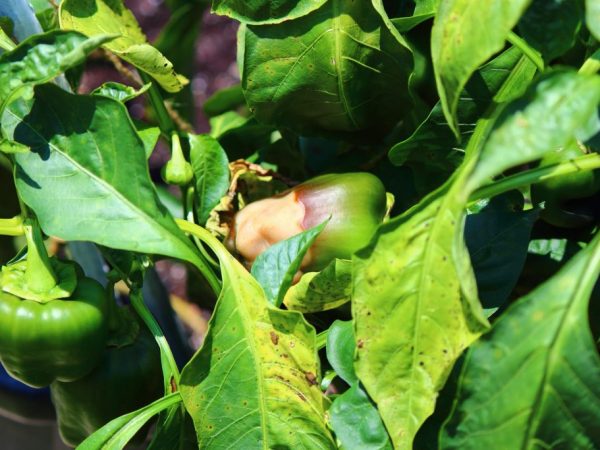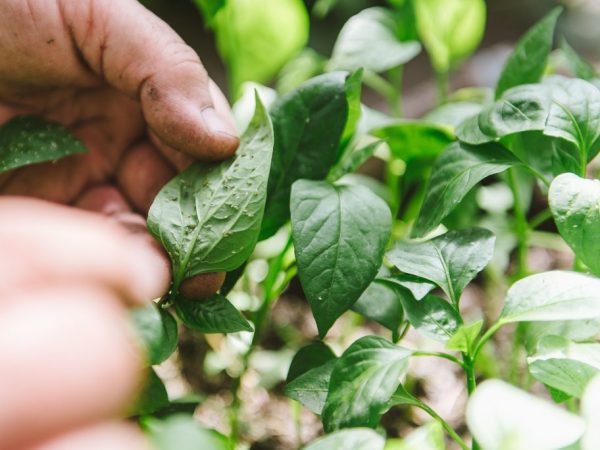Why do pepper leaves curl?
Growing peppers is not as easy as it sounds. The procedure is accompanied by difficulties that every gardener may encounter. The vigorous growth of the crop can be prevented by all sorts of diseases, pests and a lack of substances in the soil. If the leaves of a pepper curl, this is the first signal that the plant needs help.

Causes of leaf curling in pepper
Causes of leaf curling
Peppers need careful maintenance, so it is important to monitor the growth and development of the bush. When the first symptoms of leaf curling are detected, the problem must be eliminated as soon as possible.
There are 4 reasons for leaf curling.
- uneven development of leaves;
- lack of necessary vitamins and minerals in the soil;
- diseases and pests;
- wrong growing technique.
Almost always, the leaves of the pepper begin to curl at the stage of development, so the main goal of gardeners is to pay as much attention to the seedlings as possible, otherwise the plant will die.
Uneven growth
The upper leaves are deformed due to uneven development. The midveins grow rapidly and elongate the lamina. At this rate, cells and leaf edges do not have time to divide. The problem leads to curling of the foliage, and then to its contraction and deformation. Only the upper cotyledonous leaves of the plant are affected. The lower foliage, which has grown earlier, does not undergo curling and does not change in size.
The problem may be provoked by a lack of light. During this period, you need to provide the vegetable with the necessary lighting. For this, ultraviolet lamps are used, which are directed to the sheet plate. Ultraviolet light will effectively stimulate foliage growth.
Lack of micronutrients
Pepper leaves begin to curl due to the small amount of vitamins in the soil. The lack of potassium negatively affects the plant. Deficiency of this substance causes the following problems:
- a small amount of nutritional value;
- weakness of the sprouts;
- poor harvest of bell pepper;
- the risk of disease and pest damage.
Due to the lack of potassium in the ground, foliage rolls up and down. In order not to completely ruin the seedlings, it is necessary to immediately correct the situation and add all important trace elements to the soil in which the bell pepper grows.
Aphids and spider mites

Pests should be removed immediately.
The leaves are spinning due to the appearance of dangerous pests on the plant. Spider mites and aphids are lovers of sweet pepper seedlings. You can recognize the presence of pests by the following signs:
- foliage is covered with cobwebs;
- the plates acquire spots of yellow color or the foliage completely changes color;
- white bloom on foliage;
- leaves curl and small holes appear.
Insects can kill a sprout in a short time. If pests are found, you should immediately treat the bush with insecticides.
Larvae in the ground
If the foliage is curled up like a boat, the larvae live in the ground. Insects move to seedlings from contaminated soil.If the land for growing vegetables was taken from the garden and was not previously prepared for planting, larvae eggs could remain in it.
The earth has all the conditions for the development of parasites. This is facilitated by moisture and warmth. Pests kill the root system and weaken the sprouts. If you do not start acting in time, the young bush will die from a lack of nutrients in the soil or from larvae. In the fight against larvae, the biological preparation "Nemabakt" has proven itself well.
Top rot
Peppers have leaves curled due to apical rot. Top rot is a viral disease that affects weak vegetables due to a lack of calcium or a large amount of nitrogen in the soil. This disease threatens to significantly reduce yields. During the development of the bush, foliage affected by rot is twisted inward. The fruit grows defective. Brown spots form on their skin.
If the disease is detected in time, there is a chance to correct the imbalance and save the crop.
Violation of agricultural technology
If the land before planting the seedlings has passed all the necessary preparation, there are no insects, and fertilizers have been applied in the prescribed amount, the cause of the twisting of the leaves in the pepper is improper care.
Pepper is a capricious vegetable, it needs careful care and fulfillment of certain growing conditions. Insufficient lighting, lack or excess of water in the soil, as well as sudden changes in temperature greatly affect the development of foliage.
Vegetable treatment
To prevent curling, prophylaxis is carried out, but if the infection has already occurred, it is necessary to try to cure the seedlings and save the harvest. There's not always a chance to save a culture, but it's worth a try. If the leaves are curled, pay attention to the fulfillment of the growing conditions. If there are no violations, the reason lies in diseases or insects.
To get rid of aphids and ticks, the soil is regularly loosened and the seedlings are sprayed 2 times per season with Arrivo. A solution of karbofos helps well against aphids. For its preparation, take 1 tbsp. l. funds and 10 liters of water per 1 sq. m. Laundry soap is used to kill the tick. 2 tbsp. l. diluted in 10 l of water and sprayed with seedlings. Early planting and selection of disease-resistant vegetable varieties help prevent the onset of many diseases.
Preventive actions
To prevent curling of the leaves, do the following:
- disinfect the soil in the greenhouse and in the garden before planting the vegetable;
- make the necessary dressing;
- control the humidity in the greenhouse and ventilate it;
- water the seedlings at the root, do not pour water on the leaves: it must be warm and settled;
- maintain the temperature regime in the greenhouse;
- loosening the soil after watering;
- carry out mulching and clearing the site from weeds.
Conclusion
Harvesting healthy and abundant peppers is not easy. It is important to take good care of the plant, especially during the period of active growth. It is the seedlings that are exposed to various diseases and insect attacks, because the sprout at this time is very weak and is just being formed.


